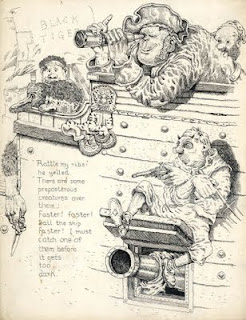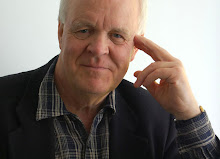.jpg)



Just as the visitor is getting used to black and white as the preferred choice and overall 'colour' of the show, one is confronted by real colour, and what an impact it makes on the eye.
Rhymes Without Reason is a tour de force of cross pollination between rhyme and artistry, where strange characters ride on upturned tables on choppy seas, crocodiles take tea with elderly females and animals of every shape and size happily go about their daily life while amusing ditties follow their every move. The colour in the room emits a radiance, and as each drawing is examined or poem read; the curator has done a brilliant job of translating into French the virtually untranslatable. Childhood beckons asking the viewer to follow each animal or person on their journey to depths of imagination.
The illustrations to accompany
Mr Pye, a novel written in the early 1950's, show a quite different talent, whereby a single line encourages us to fill in the whole while others show real beaches and bays, cliffs and paths on Sark in the Channel Islands, where the novel is set.
Perhaps the most impressive room contains the illustrations to my father's own
Captain Slaughterboard Drops Anchor first published in serial form in Country Life in 1939. Here, in a wide array of drawings outlining the adventures of the eponymous hero/villain we see his ship the Black Tiger riding the wild seas, while the fearful crew alternate between obsequious subservience to their master and unmatched joie de vivre until that is, they're made to walk the plank or die by the hand of the cutlass wielding Captain. Perhaps the Yellow Creature is the locus of the story however; half man half something else, 'he' is the last to remain alive when the idyll has been reached, a tropical island, where in the welcome shade of a palm tree he feeds grapes to the Captain while the supine master relaxes, accepts his gifts, but keeps a weather eye open for potential adversaries.
 A very enthusiastic and sensitively assessed article in the Swiss newspaper, Le Courrier, begins 'La Maison d'Ailleurs pays homage with a very singular line, to the English artist Mervyn Peake'. Picking up on the title of the exhibition, Lignes de Fuite (Lines of Flight), the correspondent elaborates by mentioning the precision and meticulous way in which the illustrator constantly strives to exclude any form of artifice from his work.
A very enthusiastic and sensitively assessed article in the Swiss newspaper, Le Courrier, begins 'La Maison d'Ailleurs pays homage with a very singular line, to the English artist Mervyn Peake'. Picking up on the title of the exhibition, Lignes de Fuite (Lines of Flight), the correspondent elaborates by mentioning the precision and meticulous way in which the illustrator constantly strives to exclude any form of artifice from his work.














.jpg)










